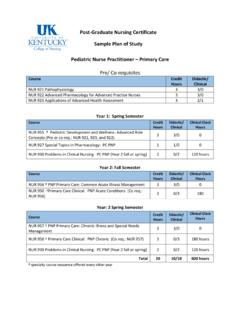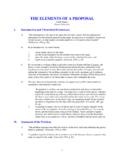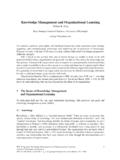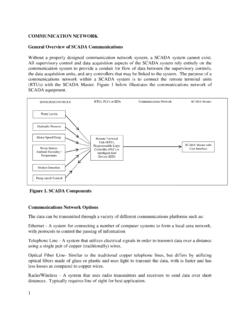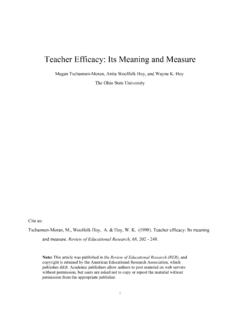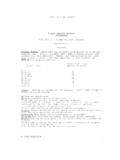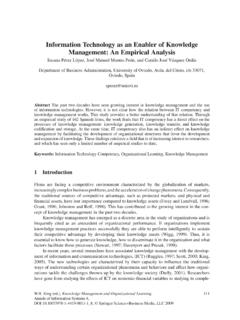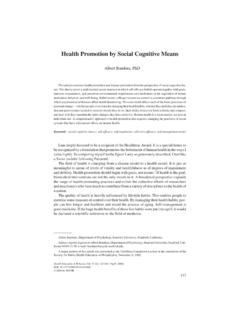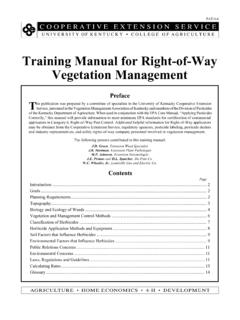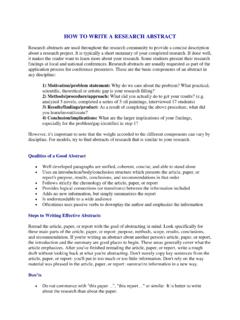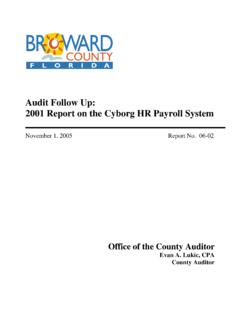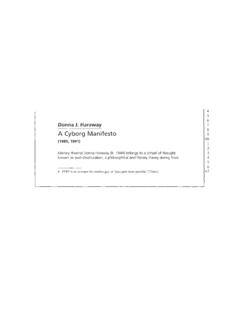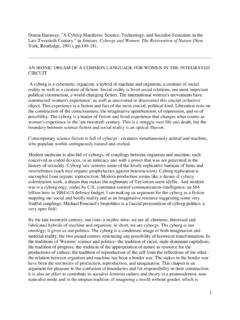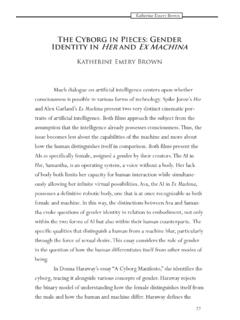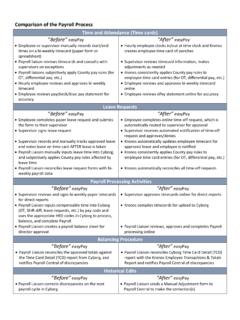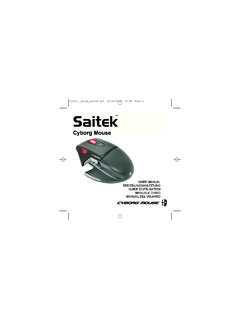Transcription of Cyborg Geographies: Towards Hybrid Epistemologies
1 Source: Gender, Place and Culture, 16(5) (2009): 499 geographies : Towards Hybrid EpistemologiesMatthew W. WilsonIntroductionCyborgs can be figures for living within contradictions, attentive to the naturecultures of mundane practices, opposed to the dire myths of self-birthing, embracing mortality as the condition for life, and alert to the emergent historical hybridities actually populating the world at all its contingent scales. (Haraway 2003a, 11) Cyborg geographies enact Hybrid ways of knowing. This article argues that the Cyborg s frequent citation as a literal marker for machinic-organic life has clouded the role of the Cyborg as a figuration. While geographic literatures have cited the Cyborg to signal an ontological hybridity, the epistemological hybridity of Cyborg figuration has been less explored. I take this argument up to articulate a renewed critical methodology in geographies of naturecultures and technosciences, as these are the domains of cyborgean inhabitation.
2 It is a call for greater specificity of the Cyborg as an artifact of feminist critiques of science a specification that actually broadens its use. Haraway s premising of the Cyborg as a machinic-organic Hybrid points to its more ontological usage. However, the larger purpose of this hybridization is to know differently our relationships with nature and technology a partial knowing that requires both ontological and epistemological hybridity. Ontological hybridity is about contingent beings and about forms of becoming that challenge dualist narratives, like human/machine, nature/society and 116 Researching Bodies, Emotions and New Materialismsthe virtual/real. geographies of naturecultures and technoscience have each interrogated these kinds of hybridities (Kitchin 1998; Whatmore 2002; Swyngedouw 1996; Schuurman 2002). However, to not engage the Cyborg as an epistemological Hybrid is to be inattentive to the partial and contingent practices of the epigraph by Haraway alludes, cyborgs are about both living within and remaining attentive to the contradictions of technoscience and naturecultures.
3 The Cyborg is therefore a simultaneous being/becoming and knowing/seeing conduit through which to conduct critical study. Human geographers have only partially made use of this conduit, for example in studies of identity in cyberspace and of urban ecologies. I argue for more attention to Cyborg Epistemologies in these spaces to further ground our critical projects in their study. I situate this proposal in research that explores boundaries and boundary-makings, such as work in naturecultural geographies that challenges scholarly convention in studying the city and the wild, and technoscientific geographies that explore the contingencies of technological and cultural production. How do we narrate the production of knowledge in these geographic subfields and what is the role of Cyborg theory in these narrations? To address this question, I propose a re-reading of Cyborg theory, such that narrations of knowledge-in-the-making are conceptualized as a witnessing, situating, acquiring and diffracting epistemological hybrids of the begin by revisiting the work of Haraway, from cyborgs to her recent writings on companion species, to demonstrate how figuration works to do subjectivities and knowledge productions differently.
4 Indeed, her work has influenced geographic study, namely in two directions: to bolster feminist critiques of the production of spatial knowledges and as a series of jumping-off points for studies of technologically-mediated spaces and human animal relations. This article is framed as primarily a critique of the latter and an extended contribution of the former. Following this review of the Cyborg as a figuration, I develop techniques for researching and writing these geographies . In the final section, I demonstrate my argument in the study of technoscientific and naturecultural space-times, by surveying the Cyborg concept in selected geographic literatures. It is important to recognize how Hybrid bodies are made in the process of these studies, as risky knowledge-making endeavors are inevitably messy and rife with boundary-crossings. This recognition involves an incessant questioning of how we know, how we theorize.
5 If the Cyborg is left to stand for only the hybridity of being, then how do we engage the Cyborg s political project of working knowledges and risky subjectivities? I argue that this engagement emerges through epistemological hybridity by placing knowledge-making actions within the messy and risky realm of creative, strategic, fallible encounters and by becoming historically aware of the everydayness of our technological l Cyborg geographies 117 Cyborg FigurationsOver two decades after she offered her manifesto for cyborgs , Haraway s reaches into the metaphorical and the figurative remain a rich source for critical engagement. The Cyborg is both a site and sighting for boundary crossings, framing the tension for this article. The Cyborg can seem to be an academic trend and while its use stretches across popular culture, cultural critique and technological innovation, it is a particular process of critique and critical engagement that deserves further consideration.
6 Here, I emphasize figuration and the Cyborg as an example of figuration, to consider its role in writing critique. What is at stake is how we know what we narrate, in projects that research the multiplicities of bodily representations through innovations like cyberspace, urban ecologies, GIS and bioengineering. These are innovations enacted through hybridity; I argue that cyborgs are writing devices to narrate these is Haraway s overarching approach in critique, while recognizing Prins (1995) argument that is it impossible to distill a methodological agenda in her research. Figuration is her aid in narration. Just as authors provide figures to illustrate arguments, figurations illustrate worlds. Haraway chooses figurations that have real meaning and then reclaims their purposes in critique, and in this sense, figurations trope. Examples include the Cyborg , gene, brain, chip, database, ecosystem, race, bomb, simian, species and fetus (Haraway 1991a, 1997, 2003a).
7 As reclamations, these figurations act as entry points. Cyborg figurations walk worlds and as Shields (2006) suggests, the Cyborg shares tendencies with fl neur. Haraway (2000, 138) describes such figurations as stem cells, [o]ut of each one you can unpack an entire world . Figurations are a kind of radical personification an inhabiting of figures with the purpose of narrating (Gane and Haraway 2006). The point of doing so is:to make a difference in the world, to cast our lot for some ways of life and not others. To do that, one must be in the action, be finite and dirty, not transcendent and clean. Knowledge-making technologies, including crafting subject positions and ways of inhabiting such positions, must be made relentlessly visible and open to critical intervention. (Haraway 1997, 36)The making of knowledge is the action of figuration, to open it to a radical visibility.
8 It is this visibility that enables intervention through the un-working and re-working of knowledge production to inspire an always partial storytelling of (post)modernity. These figurations seek to move beyond polemics and the either or jousting of certain feminisms, specifically identity politics, by entering (in order to undo) their dualistic fields of is neither entirely figurative nor literal; its political prowess lies in its ambiguity. Figurations transcend rationalities and invoke multiplicity, but 118 Researching Bodies, Emotions and New Materialismsmotivate a kind of objectivity through embodied perspective. This is described as the inhabiting of performativities (Haraway 1997, 179). Figurations are about arrangement, as a series of arguments or the composition of an image. In this sense, figurations are deeply spatial, as they are representative. Indeed, Haraway (1997, 11) invokes a mapping sense of figuration:We inhabit and are inhabited by such figures that map universes of knowledge, practice and power.
9 To read such maps with mixed and differential literacies and without the totality, appropriations, apocalyptic disasters, comedic resolutions, and salvation histories of secularized Christian realism is the task of the mutated modest map. However, these are maps of contingency and relationality. In other words, figurations form geographies , to inhabit them. That figuring is a matter of inhabitation, and that this inhabitation enables a critical visioning is the epistemological rooting of this sort of ontological messing. In a poststructural vein, Haraway is interested in what gives these figures their particular shapes and what challenges permeate their shaping. This is a renewed storytelling of re-situating these knowledges in ways that may contradict their usual moorings. In this sense, figurations both map and dis-map with their enrolling of mixed and differential literacies.
10 The Cyborg (short for cybernetic organism) is an image being continually drawn, fabricated, figured since its birth in the 1960s as the technoscientific processes of (post)modernity enable these images/imaginings. The Cyborg figuration emerges from Haraway s need to tell certain truths about scientific processes. She crafts a position (a site/citation) from which and within which to objectively narrate. The Cyborg is thus a material-semiotic entity, employed as a figuration in Haraway s critique of military-industrial relationships with science and technology. As a narrative device, the Cyborg is composed of complicated and contradictory associations: of technologies and biologies, virtualities and physicalities, discursivities and materialities. It is complicit in generative projects of difference. The Cyborg begins, after all, as the Cyborg enemy (Harvey and Haraway 1995, 514) an enemy that needs to be reclaimed, or queered, into new possibilities.
